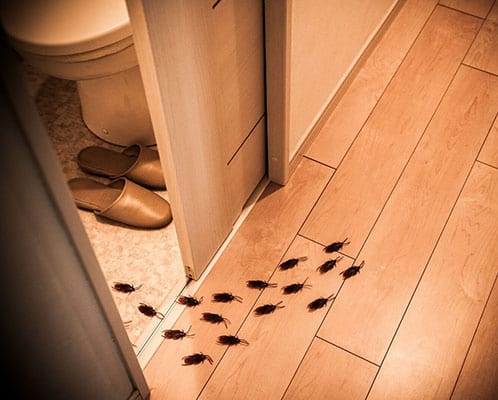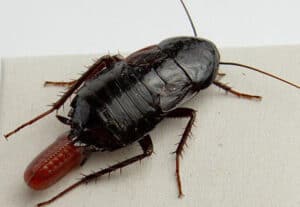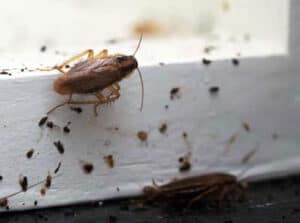Cockroaches are one of the most resilient insect species. They can live without food for days by living in moist areas. They thrive in tropical, humid, and warm climates, but some species have developed resilience to cold temperatures with time. We find infestations here in New York are mainly indoors, although there are specific cases where cockroaches will survive outdoors during the warmer months, moving from one property to another one nearby. One big concern is that indoor cockroach populations will reproduce very quickly. This means that when you see cockroach infestation signs around your home or business you should immediately contact a professional cockroach exterminator.
There are thousands of species of roaches. But fortunately, only a few live amongst us while the rest live in the woods. Each species has a different life cycle, development phases, and reproduction capacity.
Depending on the type, one can identify the growth pattern, estimate nymph development into adults, and devise a plan for extermination.
Life Cycle of a Cockroach
Roaches come from the insect family Blattodea. There are over 4,600 species of cockroaches. Only thirty of these species live in human habitats, and even fewer reside in upstate New York.
In a traditional lifecycle, the cockroach species follow incomplete metamorphosis. This means it has three stages of development: egg, nymph and adult. Most cockroaches are oviparous – meaning the females lay eggs and the young grow outside the mother’s body.
The eggs are in a small sack or capsule-like casing, ootheca, which carries all the eggs. A female cockroach can lay six to forty eggs in one term each time. Then, between six to eight weeks, the nymphs appear from the eggs. When the nymphs hatch from eggs, they are white; they start getting their brownish color as they develop.
As they scourge and feed on molting, they develop from nymphs into adults in one year. An adult cockroach lives for two years. And in that 2-year life span, a female cockroach lays 300,000 eggs a year. As a result, if cockroaches start infesting, they thrive rapidly. This is why they require a cockroach exterminator immediately upon seeing signs they are in a home.
Habitat and Food
If you know what cockroaches feed on and how they live, you can be on top of the game to invade these unsanitary creatures.
Food
Cockroaches will practically eat everything. They are omnivorous by nature and can feed on organic foods. They feast on sweet, starchy foods and meat, but they aren’t picky. They will also consume decaying matter like hair, paper and molten food. When living in sewerage, they consume sewer food. Cockroaches can feed on any protein, including human hair, so it’s almost impossible to starve out cockroaches in any environment.
Since most cockroach species live in the wild, they forage on decaying wood and leaves. In ideal weather conditions, the cockroach can go without food for weeks. And if they can consume water, they can go on without food for months.
Habitat
The habitat of the cockroach can be summarized in three words: dark, moist and food.
They are nocturnal creatures. At night when they detect no human movements, they crawl inside the house through pipes and drains.
Cockroaches are attracted to food and moisture. Therefore, infestations almost always start in kitchens or food storage areas. They cozy up in warm, moist places like under the refrigerator, sink, drawers, cabinets, under the sink, crack or crevices – basically anything dark and damp. Since they look for moist areas to nest, they are also found in vents, basements, sewers, etc.
They crawl out to forage as the night falls, consuming food and non-food items. Since they consume non-food items like certain fabrics and papers, they develop resilience to survive in clean homes.
When you find them during the day, it is a sign that there are dozens of them hiding in the house. Therefore, it is high time to call exterminators and rid them before inhabitants start falling sick.
When it comes to commercial buildings, you are most likely to find them where cleanliness is compromised – similarly, near grocery stores, restaurants, and garbage shoots.
Types of Cockroaches
Each type of cockroach has slightly different characteristics that make a massive difference in infestation, eating and reproducing patterns.
Oriental Cockroach
These roaches are also known as waterbugs and black beetle. Their shell is darker in color, and they live in damp areas.
Size: Adult male 18-29 mm; and Adult female 20-27mm
Color: Black
Habitat: Live near decaying matter, in dark spaces, mulch, bushes, drain, damp basement, porch, etc
Native: Europe, Israel, South America, Australia, Midwest, Northwest, and Southern United States.
Capacity of Ootheca (Egg Capsules): On average, ootheca carries 16-18 eggs
Diseases: With their legs they have germs like dysentery, salmonella, food poisoning and E.Coli.
American Cockroaches
They are named American Cockroaches despite their African and Middle East origin. They are also known as Bombay Canary. They have the most extensive life span among their species. They live up to 2 years and over.
Size: Adult roach is 4 cm long
Color: Brown
Habitat: Live near moist places, tropical climates, dark spaces, drain, damp basement, porch, etc. They cannot survive in cold weather but infest indoors in the northeast.
Native: Tropical regions in American
Capacity of Ootheca (Egg Capsules): On average, ootheca carries 6-8 eggs
Diseases: With their legs, they have germs like salmonella and other food poisoning, viruses, and they can trigger allergies and asthma.
German Cockroaches
German cockroaches have a rapid transition to adult roach. As soon as they reach maturity, they mate to reproduce. They are known for the speed of the armies of cockroaches they produce.
A female roach lays several eggs in her life. She guards her egg against certain predators while nymphs feed on carcasses and molten skin. Probably the reason, they breed into larger colonies.
With time they have developed resilience to common pesticides and harsh weather.
Size: Adult roach is 1.6 cm long
Color: Tan to black
Habitat: Cracks, cervices, moist places, dark spaces, drain, damp basement, porch, etc. We exterminate German cockroaches every day in upstate New York homes and businesses.
Native: It is native of North Africa but thrives in all tropical climates globally.
Capacity of Ootheca (Egg Capsules): On average, ootheca carries 50 eggs
Diseases: With their legs, they have germs like salmonella and other food poisoning, viruses, and they can trigger allergies and asthma.
7 Cockroach Infestation Signs
Signs of a cockroach infestation are not hard to miss. Some of the top ones are:
#1: Droppings
Like any other pest, it is effortless to identify its presence with droppings. The feces of a nymph look very similar to ground coffee and with variation in length for an adult cockroach.
The droppings of an adult cockroach is roughly one millimeter in length. From the size and number of droppings one can identify the nature of infestation in the house.
Wherever cockroaches infest, the place has a stench that gives away. Another classic sign is smear marks. With these cockroach infestation signs, an exterminator can calculate the enormity of the infestation.
#2: Skin Shedding
In their lifecycle, cockroaches shed their skin at least five to eight times as they grow in size. It is easy to find these skin sheddings in dark, dingy corners of the house, crack and cervices in the cabinet or under the sink and refrigerator.
Just like droppings, if you can see the shedding without making any effort, it’s highly likely there is an army of nymphs growing in the house or building.
#3: Eggs
We have already gained insight into the life cycle of how a female cockroach lays eggs in a capsule-like vessel ootheca.
It appears very similar to the skin shedding, and if you see any of these lying around, it is easy to assume there are more than thirty nymphs in the house. Only in the best-case scenario if there was one female cockroach in the house.
#4: Smear Marks – One Of The Major Cockroach Infestation Signs
When cockroaches infest a moist area, they smear the dropping as they move around. You can see the traces and smears in the high-infested area as they crawl on the wall.
Look for the dark cracks and corners, and if you see the smears, it’s time for proper extermination.
#5: Odor
Many people do not realize, but there is a powerful musty smell in a cockroach-infested area. The odor is similar to mothballs and oily for humans to identify. For cockroaches, the dropping has pheromones to attract other cockroaches. As a rule, the stronger the stench is the sign of an infestation of a big colony.
#6: Damage
We have already established cockroaches aren’t picky. Cockroaches eat anything for survival. They can infest even a clean house with no food lying around. They can begin eating non-food items like paper, clothing, etc. Cockroaches can survive by eating glue from wallpaper or other personal items to survive.
An easy indication is unexplainable holes in clothes and paper. They can even live in the closet and chew on clothes for survival.
#7: Seeing Roaches
It is an undeniable sign that you see a roach crawling around. In southern states seeing cockroaches doesn’t always mean there is an infestation. It can be a random roach strolling around the house from the outside. But in New York, if you see a cockroach, you should start the clean-up and elimination process as soon as possible.
Cockroach Infestation Signs Start With Food
In a traditional home setting, kitchens have some utensils like cutlery out in cutlery holders. Often we leave glasses lying around, and worse, fruits are left in a fruit basket on the kitchen counter.
These practices are prevalent, and one doesn’t realize that these creepy crawlers start feasting as soon as we turn off the light and head to bed.
They walk around in the kitchen and stroll over fruit baskets, utensils, cutlery baskets, etc. Their legs carry various germs and their fecal matter. Hence they spread germs all over the house. They also walk over toys that toddlers put in their mouths.
Besides an upset stomach, they also cause allergies among toddlers and infants. In a worst-case scenario, they can also cause dysentery and salmonella.
After Thought
Cockroach infestations thrive in dirty homes, but that doesn’t stop these crawlers from breeding even in clean homes. Even if you are meticulous about not leaving food out for them to forage, they can resort to paper, cardboard, and fabric for survival. So even if you only see one or two cockroach infestation signs, you should act quickly.
Eliminating cockroaches isn’t as easy as keeping your home clean. The way they find cracks and crevices to hide and reproduce is uncanny. Whether you live in a single-family home or an apartment complex, without professional intervention, you can plan on these uninvited guests staying for the long haul.
How To Prevent Cockroach Infestations
Here are some ways to prevent these infestations from coming back.
- Seal the cracks and cervices.
- Keep the doors and windows close at night.
- Varnish the wooden panels.
- Use insecticides in entryways.
- In spaces with toddlers, you can try using peppermint oil, cedarwood oil and cypress oil.
- Boric acid only entry points.
- Spray disinfectant on kitchen countertops and appliances at night.
Here are some ways to not make them feel welcome in your homes.
- Keep the food in sealed jars if left out on kitchen counters.
- Make it a practice to leave no liquid in the sink or bucket.
- After every meal prep, clean the working top and remove food debris.
- Throw away trash daily or keep them in sealed bins.
- Never leave pet food or water out at night.
- Clear the litter tray before heading to bed.
- It is best practice to rinse bottles and cans before throwing them in recycle bin.
- Make sure to remove old magazines, newspapers, books and especially cardboard boxes.
- And lastly, keep your living space clutter-free. A clean space with fewer advantages makes it difficult for them to thrive.
Cockroaches are resilient creatures, with their ability to adapt to weather, living conditions and food choices. The infestation is hard to stop and can cause diseases and various infections to home dwellers. What’s worse, they can start chewing on your clothes and books. If you see signs of an infestation in your home, look to the professionals who have complete knowledge of eradicating the pests.
EnviroPest is one of the masters in clearing your homes from such pests. At EnviroPest, we provide high-end services with top-quality organic products. We handle problems in every region of upstate New York. They have highly professional and trained staff with experience of over ten years. Our services are always guaranteed, and packages include all the services required to eliminate cockroaches and their eggs.
Contact EnviroPest the moment you see cockroach infestation signs.




